
The Deepwater Horizon oil spill overlapped with the spawning activities of many ecologically and economically important tuna species. However, the significant knowledge gap regarding early life stage tuna taxonomy and distribution makes it difficult to understand how the spill may have affected them.
As a graduate student, Nina Pruzinsky examined the abundance, distribution, and morphological characteristics of larval and juvenile tunas (Scombridae) and identified primary drivers of their distribution to help fill this gap and inform future management and conservation efforts.
Nina, who recently completed her graduate studies, was a master’s student in Nova Southeastern University’s Department of Marine and Environmental Sciences and a GoMRI Scholar with the Deep-Pelagic Nekton Dynamics of the Gulf of Mexico (DEEPEND) Consortium.
Her Path
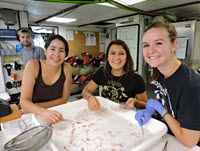
Nina discovered her interest in environmental research during high school class trips to Virginia and Jamaica. She and her classmates surveyed diverse environments, such marshes and coral reefs, and learned about the marine and terrestrial organisms living in them. These hands-on experiences along with a freshman ocean science class at the University of Delaware prompted her to pursue an environmental science degree. As an undergraduate student, she studied in the Cayman Islands, obtained an AAUS Scientific Diver certification, and interned in Dr. Mark Warner’s Algal Physiology Research Laboratory, where she studied coral symbiotic dinoflagellates. However, Nina realized that she was most interested in researching poorly studied fish taxa.
After reading several of Dr. Tracey Sutton’s deep-sea research articles, Nina applied for an open graduate research position at his Nova Southeastern University Oceanic Ecology Lab. When she began working with Sutton, he was leading the DEEPEND Consortium, which had just begun their work assessing how the Deepwater Horizon oil spill may have damaged the Gulf of Mexico’s little-explored deep-sea ecosystems. “My personal goal is to provide information that can help maintain and assess populations and ecosystems,” said Nina. “Seeing how DEEPEND was designed for new discoveries and assessing the oil-damaged water column drove my decision to work with Dr. Sutton.”
Her Work

Juvenile tunas are particularly difficult to identify to the species level (there are 15 tuna species worldwide). Although larval tunas are well-described, juveniles grow out of many diagnostic larval characteristics but have not yet developed the adult features needed for identification. Nina examined the morphological characteristics of over 900 larval and juvenile tuna (Scombridae) specimens collected during seven northern Gulf of Mexico research cruises in 2010 – 2011 and 2015 – 2017. She identified each larval and juvenile tuna specimen to the lowest taxonomic level possible and confirmed her identifications using genetic barcoding. Then, she identified physical characteristics unique to each undescribed juvenile tuna species, finding that body ratios and spine/fin ray counts were key morphological characteristics for identification.
Nina calculated species-specific body ratios using measurements of the head, upper jaw, snout, eyes, and fins. She then observed if and how these ratios changed as early-life-stage tuna matured. Combining reported ratios and her new ratios, she determined the definitive physical characteristics that can be used to identify different juvenile tuna species. “Species-specific body ratios can either be used in conjunction with morphological characteristics or on their own,” said Nina. “For example, a known diagnostic feature of larval and (now) juvenile Acanthocybium solandri (wahoo) is that their snout is twice the size of their eye diameter. However, A. solandri can also be identified using fin ray counts. Both approaches are useful, depending on the condition of the specimen.”
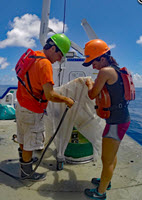
Nina determined the faunal composition and standardized abundance for tuna samples collected during the seven research cruises. She observed that Euthynnus alletteratus (little tunny), Thunnus atlanticus (blackfin tuna), Auxis thazard (frigate mackerel), and Katsuwonus pelamis (skipjack tuna) were the most-abundant species in the analyzed samples. Using sampling location, Nina modeled the distribution of these species and statistically compared their abundance patterns to variables that may drive early life stage assemblage structure and distribution, including location and depth, time of day and year, and oceanographic features such as salinity and temperature. Although each tuna species exhibited a different vertical, seasonal, and horizontal distribution pattern, Nina observed that seasonality and species-specific environmental preferences (such as salinity level) were the main drivers of spatial distribution across the Gulf of Mexico.
“More oil rigs are being added throughout the Gulf, especially in waters that overlap with tuna spawning sites, increasing the chance of another spill. As larvae are planktonic [only float, not swim], they will not be able to avoid an oil spill,” said Nina. “Understanding the distribution, drivers of assemblage structure, and faunal composition of Gulf of Mexico tunas will assist management and conservation efforts, help assess how an oil spill impacts vulnerable early life stages, and potentially predict future year class strength.”
Her Learning
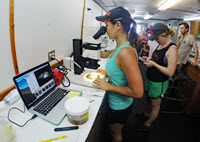
Nina participated in two deep-sea research cruises and two DEEPEND ichthyoplankton research cruises while working in Dr. Sutton’s lab. During these expeditions, she led the data management and cruise planning efforts, interacted with colleagues from other institutions, and gained hands-on experience with the sample collection process. “Working with DEEPEND, there is always a chance to see something new, whether that is new to science, new to the Gulf, or new to my own personal experiences,” she said. “The excitement and comradery among the science crew was contagious, and I was constantly learning through either my own experiences or from hearing my colleagues’ stories. I would not trade that experience for the world!”
Nina said that being a part of the GoMRI community was extremely rewarding, especially learning from and sharing her research with scientists from other fields and projects. She said, “So far, I have presented at several conferences and was an invited speaker at the 2019 Gulf of Mexico Oil Spill and Ecosystem Science Conference in New Orleans, LA. It is an incredible experience learning about the research going on within the Gulf of Mexico and telling my own story.”
Her Future
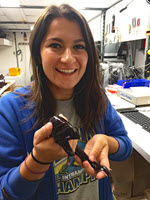
Nina completed her master’s degree in 2018 and is continuing her DEEPEND research as a Research Associate and lab manager in Dr. Sutton’s Oceanic Ecology Lab. When she isn’t on a research cruise, she manages multiple large databases, oversees sample collection and processing, writes cruise reports, participates in education and outreach efforts, and trains graduate research assistants, students, and volunteers. She hopes to continue working with people within and outside of academia and apply her growing research and managerial skills to her future career.
Nina suggested that students pursuing an environmental science or marine biology career should volunteer or intern in different laboratories to gain experience in various scientific fields. She reflected that her own career began working with dinoflagellates but eventually led her to deep-sea and tuna research. “Get involved!” she said. “You never know where your interests will take you.”
Praise for Nina
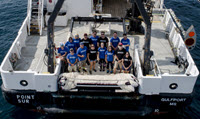
Dr. Sutton said that Nina impressed him from her first interview with her academic record, writing skills, talent, drive, and joyful personality. “After I advertised the first two research assistant positions for DEEPEND, I sorted the applications into two folders: Nina Pruzinsky and everyone else,” he joked. It was no surprise to him when Nina became a pillar in his lab while also tackling challenging morphological analyses and conducting advanced biophysical modeling.
“Simply put, if I had a nickel for every time a troubled student or even a DEEPEND co-PI uttered the phrase ‘I’ll ask Nina,’ I could probably fund another student,” said Sutton. “I was dreading the thought of lab operations without her after she defended her thesis and was so overjoyed when she chose to stay with us as a Research Associate. I feel comfortable speaking for both myself and every co-PI when I say that she has been one of DEEPEND’s brightest stars.”
The GoMRI community embraces bright and dedicated students like Nina Pruzinsky and their important contributions. The GoMRI Scholars Program recognizes graduate students whose work focuses on GoMRI-funded projects and builds community for the next generation of ocean science professionals. Visit the DEEPEND website to learn more about their work.
By Stephanie Ellis and Nilde Maggie Dannreuther. Contact sellis@ngi.msstate.edu for questions or comments.
************
The Gulf of Mexico Research Initiative (GoMRI) is a 10-year independent research program established to study the effect, and the potential associated impact, of hydrocarbon releases on the environment and public health, as well as to develop improved spill mitigation, oil detection, characterization and remediation technologies. An independent and academic 20-member Research Board makes the funding and research direction decisions to ensure the intellectual quality, effectiveness and academic independence of the GoMRI research. All research data, findings and publications will be made publicly available. The program was established through a $500 million financial commitment from BP. For more information, visit https://gulfresearchinitiative.org/.
© Copyright 2010-2019 Gulf of Mexico Research Initiative (GoMRI) – All Rights Reserved. Redistribution is encouraged with acknowledgement to the Gulf of Mexico Research Initiative (GoMRI). Please credit images and/or videos as done in each article. Questions? Contact web-content editor Nilde “Maggie” Dannreuther, Northern Gulf Institute, Mississippi State University (maggied@ngi.msstate.edu).
